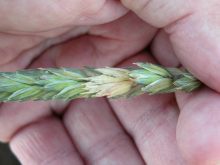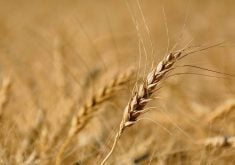Playing the grain-grading game successfully starts with collecting a truly representative sample from your crop, the former chief grain inspector for Canada told farmers meeting here recently.
It also requires understanding the differences between Canada and the U.S. grading systems, said Norm Woodbeck, who retired from the Canadian Grain Commission in 2011 and now works for private grain grader Intertek Commodities Services.
“I don’t care how good you are as an inspector. I don’t care what you have for equipment — you could have the fanciest lab in the world — everything that you do is based on that sample,” Norm Woodbeck told farmers attending the Boundary Loading Group’s second annual meeting Dec. 10.
Read Also

Manitoba sclerotinia picture mixed for 2025
Variations in weather and crop development in this year’s Manitoba canola fields make blanket sclerotinia outlooks hard to pin down
Farmers are generally good at collecting grain samples from every load as they move grain from the combine into storage bins. They should also make sure grain buyers are getting a representative sample when the grain is delivered to the elevator, said Woodbeck.
That means getting multiple samples from a load and not a few scoops as grain first pours out the back of the truck.
“That’s where all the chaff is so you’re going to get an unrepresentative sample for dockage,” he warned. “Sample it from start to finish, that is the key.”
Varying samples is why sometimes farmers get different grades from different grain buyers for what is supposed to be the same grain, Woodbeck said.
“In theory they could be both right.”
Swirling a grain sample around in a pail and then dumping it isn’t the best way to get a representative sample either, especially in a crop such as soybeans where a bit of shaking sends all the lighter dockage to the bottom.
Large grain samples need to be reduced. Placing a piece of paper between two adjoining tubs is a relatively accurate way to divide a sample. But even when very expensive reducing equipment is used, there will be variability.
Woodbeck ran a test using the Boerner divider, an expensive piece of equipment the grain commission and Intertek use to reduce samples. He took 1,000 grams of durum wheat and dyed five grams creating a sample that contained 0.5 per cent dyed kernels.
The sample was divided 25 times. Each time Woodbeck weighed the dyed kernels. The results varied a lot with the lowest level of dyed kernels at 0.08 per cent and the highest at 0.92 per cent. But when averaged, the dyed kernels came out at 0.52 per cent dyed — almost exactly the percentage of the original sample.
If the dyed kernels were in fact fusarium-damaged kernels, one of the samples would have graded a No. 3 and another a No. 1 Canada Western Amber durum, Woodbeck said.
“You have sampling error, dividing error and then you throw a bunch of grain inspectors into the mix and they have different eyes and the way they look at it you’ve got more variability in there,” he said.
In addition to visually grading grain, laboratory tests are often done on wheat to assess its falling number and levels of DON (deoxynivalenol), a toxin sometimes produced by fusarium head blight.
In a 1,000-gram sample, one badly sprouted or DON-laden kernel — the so-called “nugget effect” — “can throw your test right out the window,” Woodbeck said.
A low falling number or high level of DON will lower the grade and the value of a farmer’s wheat. (See sidebar.)
He advised farmers to get their wheat graded before marketing.
To attract harvest samples in the fall, the Canadian Grain Commission will provide farmers with a free protein test and grade. Grain companies will also grade grain for farmers.
Farmers shipping grain on the Boundary Trails Railway (BTR) get free grading through Intertek. Some farmers using BTR are shipping grain to the U.S., which has a very different grading system.
“My advice to producers… is to learn both systems, understand the different terminologies and the different factors and don’t try to compare them,” he said. “They are apples and oranges.”
For example test weight in the U.S. is based on a Winchester bushel, which is smaller than a Canadian bushel. Both countries use the same moisture-testing equipment, but they are calibrated differently so results will differ too.
The grain commission’s website has test weight and moisture conversion tables.
Instead of wheat grades dropping from a No. 1 to a No. 2 and then a No. 3, in the U.S. a No. 1 Dark Northern Spring wheat will drop to a No. 1 Northern Spring and then to a No. 1 Red Spring.
“In theory you could go down (to the U.S.) and get two per cent severely sprouted wheat, (which) in Canada would be a feed wheat and it would still qualify for a No. 1 wheat in the U.S.,” Woodbeck said. “Now that’s why they want to know the falling number and with fusarium, they want to know the DON (levels) besides the grade.”




















